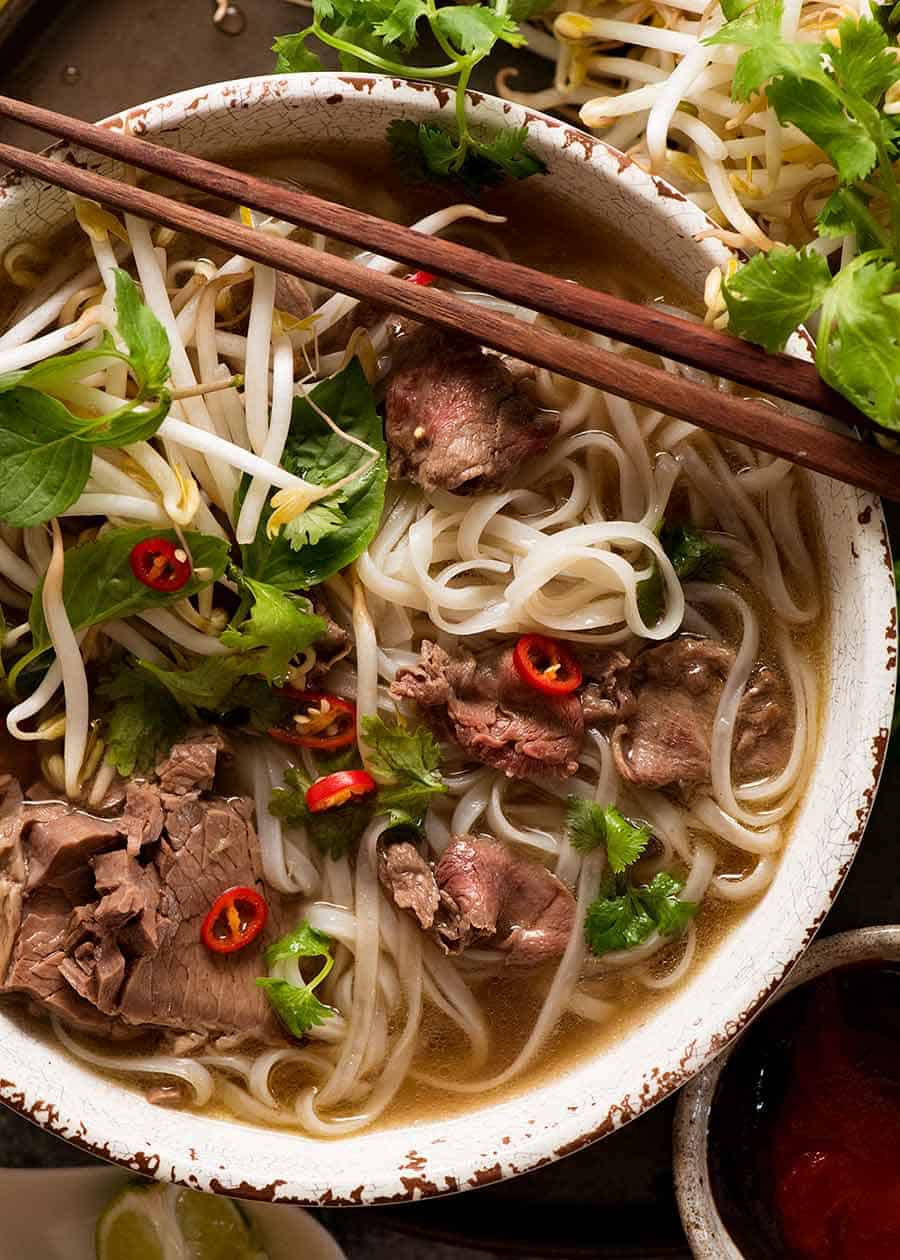
PHO (VIETNAMESE NOODLE SOUP)
Phở is a Vietnamese noodle soup that has become an iconic dish, beloved around the world for its complex and delicious blend of flavours. With a rich history stretching back over 100 years, phở is considered one of Vietnam’s national dishes, and an integral part of its cuisine and culture. This hearty and comforting noodle soup is highly versatile, with many regional variations and customisation options. From the sweet and savoury broth, to the fragrant herbs and vegetables, to the tender noodles and meat – every component of phở is carefully crafted to create a mouthwatering experience. While phở restaurants can now be found in cities across the globe, Vietnam remains the true home of this exceptional dish.
History of Phở noodle soup
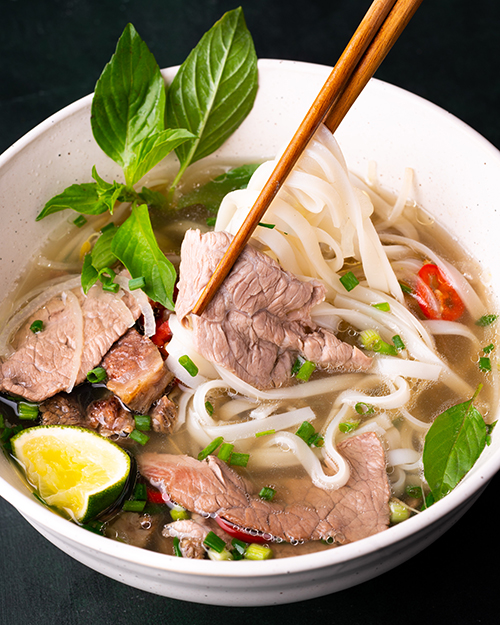
Phở has a long and storied history in Vietnam, though its precise origins are debated. Here is an overview of some key facts and theories regarding the history of this iconic soup:
Northern-Style Pho:
Northern-style phở is considered the original and most authentic version of the dish. It likely originated in the early 20th century in northern Vietnam, around the capital city of Hanoi. Some theories suggest that phở was adapted from the French beef stew called pot-au-feu, which was introduced during French colonial rule. The clear broth and wide, flat noodles typical of northern phở may reflect French influences. Other theories trace phở’s origins to various Vietnamese noodle dishes like hủ tiếu and bánh canh. Whatever its exact origins, northern phở became popular with working class and peasant communities in the North of Vietnam, often sold as an inexpensive, quick meal by roving street vendors carrying a shoulder pole with the soup ingredients. The dish was a creative use of beef, which had become more widely available in the 1920s and 30s. Over decades, the recipe evolved, eventually taking on the more complex spice profile we now associate with phở.
Northern-style phở broth is made by simmering beef bones, charred onions and ginger, and warm spices like star anise, cassia, and clove. It is delicately flavored, clear, and fragrant. The flat rice noodles are wider and more supple. Common garnishes include green onion, shallots, and a plate of fresh herbs like basil, mint, cilantro, and bean sprouts. Slices of rare beef are added to the hot broth just before eating. This pure and classic version of phở remains popular in Hanoi and across Northern Vietnam.
Central-Style Pho:
After the partition of Vietnam in 1954, phở began evolving into regional variations as it spread through the centre and south of the country. Central Vietnam, with its hotter climate, produced what is now known as central-style phở. This version features a broth with a punchier, spicier flavor profile. Central phở broth is often made with a blend of beef and pork bones. Spices like coriander, cassia, star anise and cloves add fragrance, while chili peppers bring heat. It may also contain shrimp paste or mam tom for added umami savoriness. The noodles are slightly thinner than northern-style phở noodles. Herb garnishes remain important, but vegetables also play a bigger role, with cuts of white onion, bean sprouts, lime wedges, chili slices and fresh herbs accompanying the dish. Central-style phở is often topped with a tangle of protein options – beef, pork, chicken, shrimp, fish cakes or fried tofu. This hearty phở variation is suited to the hot climate and vibrant food culture of Central Vietnam.
Southern-Style Pho:
Finally, Southern-style phở emerged after phở migrated from North to South. The southern climate and tastes lent themselves to a phở with a brighter, cleaner, sweeter broth. Southern-style phở broth starts with beef bones but often incorporates chicken bones as well for a lighter body. Onions and spices like cinnamon, star anise and clove feature prominently. Coconut water or juice may be added for subtle sweetness. The noodles are the widest and chewiest of the three styles. Pork, chicken, seafood and herbs garnish simple bowls of southern phở. Bean sprouts, lime wedges, fresh chilies, and a variety of sauces allow diners to customize their dish. With its emphasis on aromatics and adaptability, Southern phở has come to be known as the most approachable, versatile version of Vietnam’s beloved noodle soup.
Preparation of Pho:
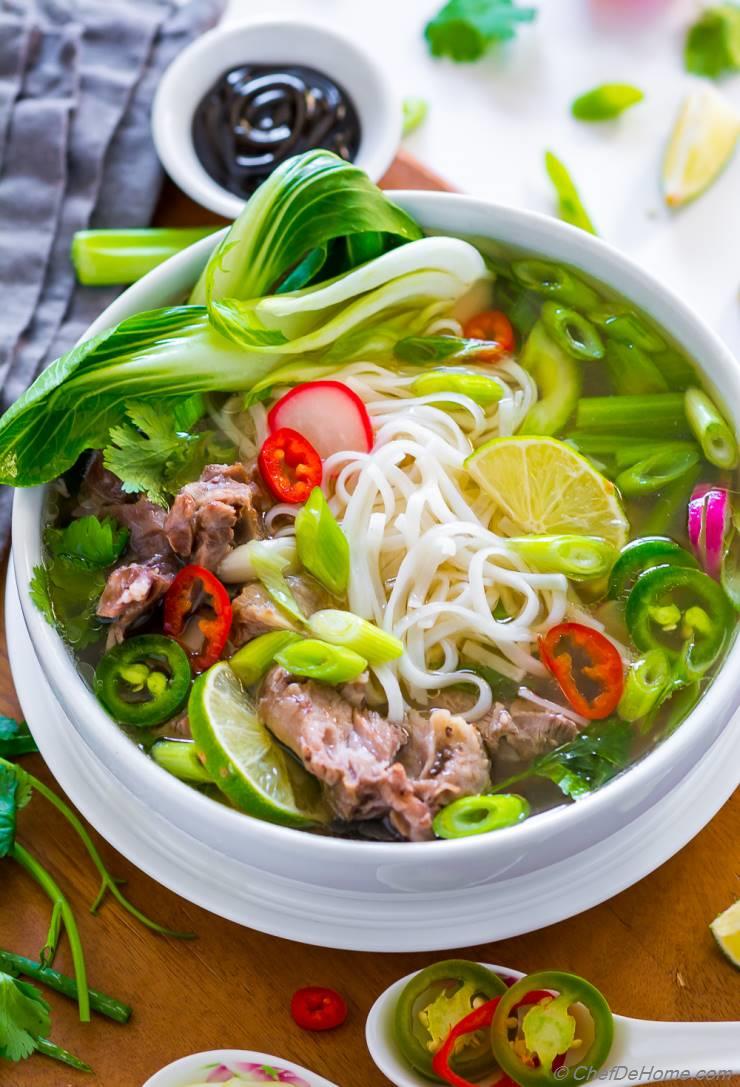
To fully appreciate phở, it helps to understand the intensive process required to create an authentic bowl of this soup. Here are some key steps and tips on making proper phở:
- The broth – This is the soul of the dish. Beef bones are blanched then simmered for 4-6 hours with charred onion and ginger. Spices like cinnamon, star anise, coriander seed, fennel seed, and rock sugar are toasted then tossed into the pot. Finally, fish sauce adds depth. For clarity, the broth is strained through fine mesh.
- The noodles – Traditional phở uses bánh phở, fresh flat rice noodles that are cut into slender strands. Quality phở noodles should be silky, chewy and hold up well in the broth. Noodles are dunked in hot water before serving to remove starchiness.
- The meat – Thinly sliced rare beef is absolutely integral to phở. It can also include other cooked meats like brisket, meatballs and chicken. Raw meat is quickly blanched in the hot broth right before serving.
- Assembly – Phở is assembled in layers, starting with noodles and blanched meat in the bowl, followed by hot broth ladled over the top. On the side, a plate of bean sprouts, basil, lime wedges and other fresh herbs and vegetables is provided for diners to add to taste.
- Customization – Regional phở variations demonstrate the dish’s incredible adaptability. Diners can make the soup their own with additions like hoisin and sriracha sauce, chili peppers, and extra herbs, spices or lime juice.
When all elements come together – the aromatic broth, tender noodles, thinly sliced meat, and fresh garnishes – the result is a perfect symphony of textures and flavours that makes phở so craveable!
Overview of Pho
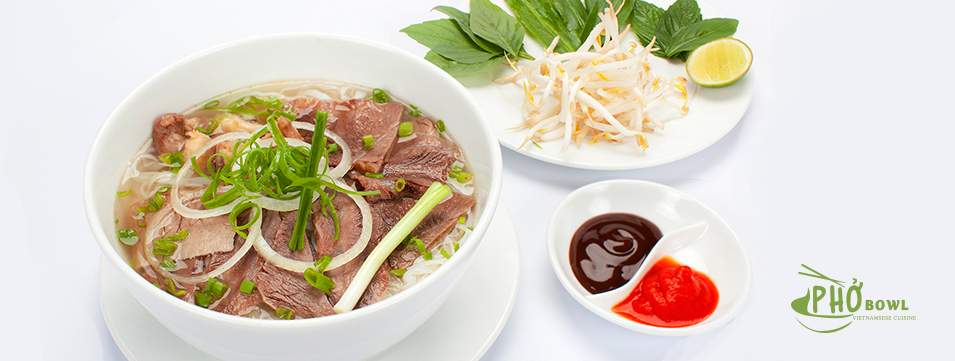
As one of Vietnam’s national dishes, phở is rich in cultural history and variety. Here is a brief overview of some key aspects that define this iconic noodle soup:
Origins – Phở emerged in Northern Vietnam in the early 1900s and evolved over decades into many regional variations. The French colonial introduction of beef and bread likely influenced its development.
Broth – The broth is the heart and soul of phở. It simmers for hours and contains beef or chicken bones, warm spices, charred onions/ginger and fish sauce. Regional broths range from delicately spiced to pungent and hearty.
Noodles – Phở is served with fresh bánh phở noodles – flat, slender, chewy rice noodles that soak up the flavorful broth.
Meat – Sliced rare beef is essential, though some versions also contain brisket, meatballs, chicken, or seafood. The raw meat cooks quickly in the piping hot broth.
Garnishes – On the side, diners add bean sprouts, herbs like basil and cilantro, lime wedges, chilies and more to taste. This allows for personalization and regional diversity.
Versatility – Beyond regional variations, phở remains highly customizable. Diners tweak their bowl with hoisin, sriracha, veggies, herbs and other accents.
Popularity – Phở has transcended borders, gaining global fame. Yet Vietnam remains the true spiritual home of this nourishing, aromatic noodle soup.
Where to Eat Phở in Vietnam
As the birthplace of phở, Vietnam offers food lovers the chance to experience truly authentic versions of this famous noodle soup. Here are some highly rated spots to savor perfect bowls of phở across regions in Vietnam:
Hanoi
- Phở Gia Truyền – Historic Hanoi restaurant serving up northern-style phở for over 50 years. Known for excellent noodles, fragrant broth and high-quality beef. Bustling atmosphere with swift service.
- Phở Bát Đàn – Tiny street-food shop popular with locals for mouthwatering classic phở served till late. Limited seats so takeaway is common.
- Phở Thìn – Unpretentious, long-running family business dishing up tradition Hanoi-style phở with silky noodles and deeply flavored broth.
Huế
- Phở Hòa – Local favorite serving the hot, spicy phở central Vietnam is renowned for. Known for ultra-fresh rice noodles, tender beef and pork, and pungent broth.
- Hanh Phở – Top spot for Huế-style phở with light yet complex broth, a variety of meat options, and lovely noodle texture. Third-generation family business.
- Lien Hoa Phở Restaurant – Humble streetside eatery preparing noodle soups the old-fashioned Huế way. Savory broth and wide noodles are highlights.
Ho Chi Minh City
- Phở Hòa Pasteur – Historic Saigon phở joint attracting locals, tourists and late-night crowds. Offers sweet, fragrant broth, tender meat and loads of herbs.
- Phở 2000 – Modern chain started by former South Vietnam Prime Minister serving signature phở with chicken or beef alongside spring rolls.
- Five Oysters – Trendy restaurant putting a modern twist on phở with unique ingredients like oxtail and pork ribs and micro-herb garnishes.
Wherever you travel in Vietnam, look for small, crowded phở restaurants filled mostly with locals – this is often a sign of an excellent noodle soup!
Tips for Enjoying Phở
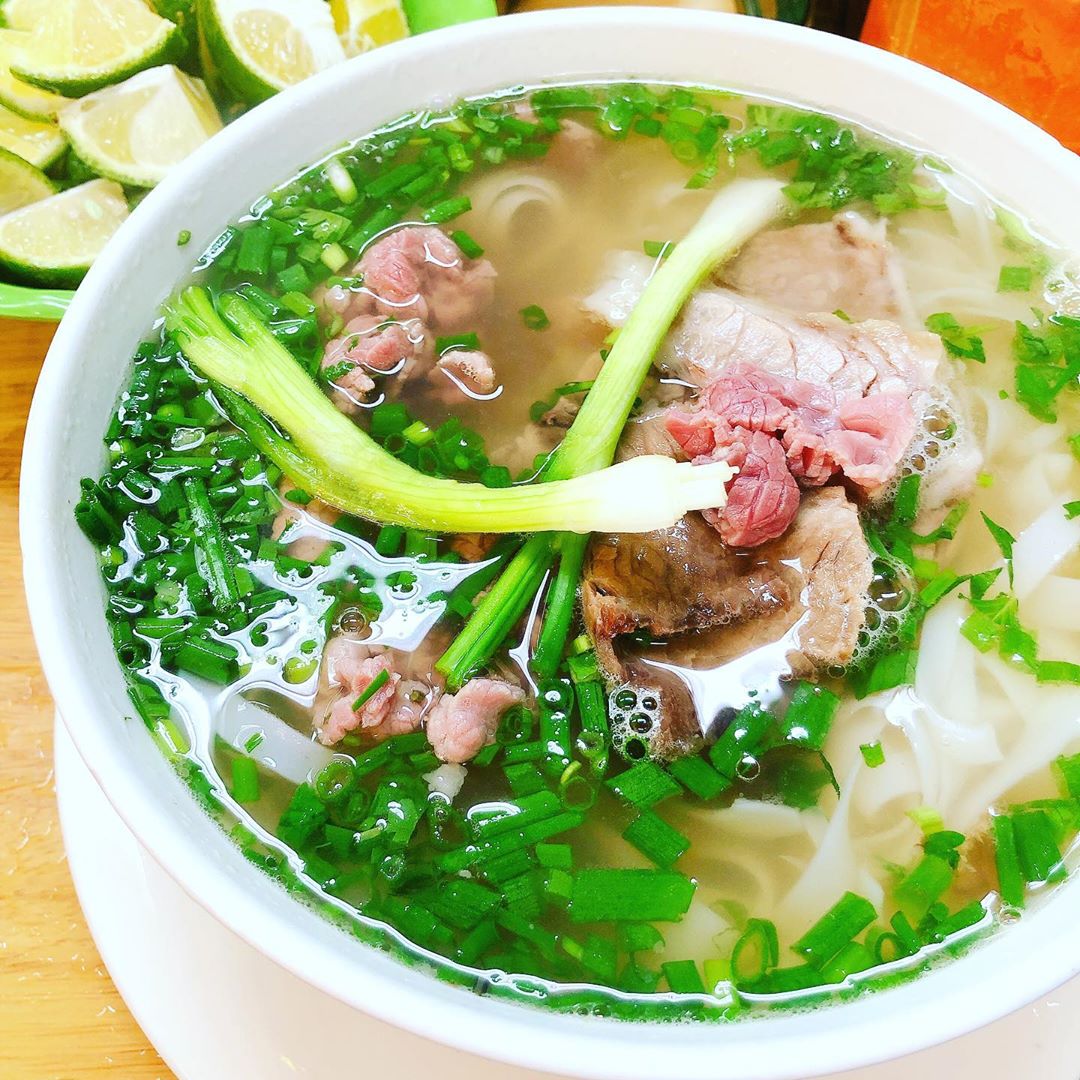
As with any revered food tradition, there are certain tips and etiquette to maximize your phở enjoyment:\n\n- Add chili, hoisin or sriracha – Don’t be shy about seasoning your broth to taste preferences. This is customary.
- Mix the broth – Before digging in, stir the broth once or twice to better integrate the flavors.
- Go upside down – Many Vietnamese turn the bowl upside down over the plate to eat the noodles, allowing broth drainage.
- Mind the temperature – Allow the phở to cool briefly if it’s too scalding hot to enjoy right away.
- Slurp the noodles – Make some natural slurping sounds while eating the noodles – this aerates the broth.
- Garnish generously – Heap on herbs, bean sprouts and greens to balance the richness.
- Savor the nuances – Take time to appreciate the layered aromas and flavors in each spoonful.
- Use chopsticks – Chopsticks are the customary utensil for eating phở, though spoons are also provided.
- Drink the broth – End your meal by sipping the remaining hot, satisfying broth from the bowl.
Top 5 Frequently Asked Questions About Phở
Phở is clearly a cherished noodle soup with a long, evolving tradition and legions of fans worldwide. Here are answers to 5 of the most commonly asked questions:
1. What are the main ingredients in phở?
The main ingredients are broth, rice noodles, herbs, and meat – typically beef or chicken. Signature seasonings include charred ginger and onion, star anise, cinnamon, fennel seed, clove, cardamom and fish sauce. Popular garnishes are bean sprouts, cilantro, basil, lime, chilies and hoisin sauce.
2. Is phở gluten free?
Yes, traditional phở broth and noodles are gluten-free, making phở a tasty gluten-free option. Bánh phở rice noodles contain no wheat. Always check with your server about possible gluten from soy sauce or other added ingredients.
3. How many calories are in phở?
On average, a large bowl of beef phở contains around 400-500 calories. This provides a satisfying meal full of protein, carbs and nutrients without excessive calories, thanks to the broth-based broth and fresh ingredients. Vegetarian phở or versions with extras like fatty brisket can ring in a bit higher.
4. Is phở healthy?
Known for its balance of proteins, carbs, herbs and spices, phở can be a wholesome, nourishing food. The broth delivers minerals from bones along with hydration. Watch out for high sodium levels at some restaurants, and keep portion sizes reasonable.
5. How do you properly eat phở?
Customize your phở with desired sauces, greens and herbs. Stir the broth before enjoying its aroma. Twirl noodles around chopsticks and gently slurp them from the spoon to aerate. Drink any remaining hot broth to finish. Phở is eaten communally and casually.
Conclusion
With its complex layers of flavor, heartiness, and customization, phở has earned global appeal while remaining Vietnam’s pride and joy. This noodle soup has a storied past, highlighting Vietnamese resourcefulness and creativity. Regional variations as well as diner modifications further showcase the adaptability of phở. At its best, each bowl of phở is like a carefully crafted symphony – deeply comforting yet uniquely personalized. For the ultimate phở experience, a journey to its homeland is essential. Luckily, excellent bowls of this brothy, aromatic noodle soup can be found all across Vietnam.
Source: https://visaonlinevietnam.com/pho-noodle-soup-a-feature-of-hanoi/

